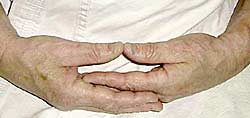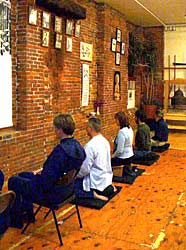Meditation: Just Do It!
By Jeff Brooks
Editor’s Note: This is
the second of a three-article series on meditation (Zen) and the
martial arts. This article examines some of the techniques and methods
of meditation itself. Part one, “Holding
Hands With Zen: The Martial Arts Connection - An Interview With
Jeff Brooks” discusses how Zen complements the martial arts
by helping to develop total concentration without thought, something
that allows greater spontaneity of action. The third article in this
series, “Fighting Zen – How Mediation Can Enhance Your
Fighting Skills,” by Christopher Caile, will discuss how Zen
skills are actually put to use in fighting and self-defense situations. |
 |
The traditional descriptions of meditation in the Buddhist
tradition are many and varied. But they all share some aspects. In our
tradition,
our practice of shikantaza, or "just sitting," we withdraw
our senses and allow our minds to settle down. We sit with legs folded,
on a round cushion (zafu) which elevates the base of the spine slightly
above the knees. We keep the spine tall, not leaning left or right, forward
or back. The head is high, not tipping over. The tip of the tongue touches
the back of the top teeth. Other alternatives for sitting are to kneel
(seiza) with the aid of a short bench (seiza bench) to elevate the hips,
or to use a chair for those with physical limitations.
There are esoteric explanations for all of these elements, but they
all have ordinary practical functions. For example, the tongue position
allows our swallow impulse to subside, so we can sit more peacefully.
 The eyes are neither all the way open nor all the way closed, just half-open
and cast down about 45 degrees, with a relaxed gaze. The hands are cupped,
left inside the right, the thumbs touching lightly to form a small
circle, with the arms resting on the thighs. The eyes are neither all the way open nor all the way closed, just half-open
and cast down about 45 degrees, with a relaxed gaze. The hands are cupped,
left inside the right, the thumbs touching lightly to form a small
circle, with the arms resting on the thighs.
Some people find it difficult at first, but after a while it becomes
natural. This posture is very stable, allowing you to enter a relaxed
physical state without tipping over. In our style we sit facing the wall,
which minimizes visual distraction. In other styles people sit facing
one another, or in rows facing a teacher or altar.
The environment in which we meditate ought to be without too much stimulation
- it should be quiet, not too bright or too dark, not too hot and not
too cold, without strong odors or perfumes, and without the likelihood
of disturbance from people or animals. We should avoid moving - in order
to scratch and itch or to relax a muscle - because the sound of us moving
may distract others, and also because it stimulates our own sense of
touch. If you let it, the urge to move will subside and you can sit very
deeply.
We make an effort to withdraw the five senses of perception so that
we let go of our habit of grasping at sight, sound, smell, taste and
touch. We also withdraw our mental grasping at thought. That is: we just
sit. If, when you are sitting, you notice that your mind is slack and
you begin falling asleep, don't yield to it, just sit strong and tall.
If you notice you are agitated and fantasizing, planning, remembering
and so on, let it go ("open the hand of thought") and just
sit. That's it.
 |
Members of the Northampton
Zendo come together on Monday nights for group meditation.
The room doubles as the Northampton Karate Dojo, and the
important idea of "karate and Zen as one" is evident
in the way Buddhist calligraphy and images shares wall space
with photos and images related to karate.
|
|
This
may sound too simple to be profound. Many meditation traditions teach
other methods. These other methods are all different from "shikantaza" (Japanese
for "just sitting") in that they provide for an object of
attention. That is, they give you something to think about (focus on)
or something to do while meditating. A mantra (sacred phrase), a visualization,
a sound, the breath (or counting breaths trying not to lose focus),
various good ideas and so on for the object of attention during meditation
practice. The mind focuses on one of these and in making an effort,
the person's attention becomes more stable, clearer and more enduring.
In shikantaza there is no object of attention. This is especially disconcerting
and it leads people to ask what we are supposed to "do?" Just
sit. But what does that mean?
Don't daydream, don't fall asleep. That's it. But what do you DO? Just
sit. In shikantaza the emphasis in the explanation of the method of practice
is placed on what you don't do. To come face to face with the way our
minds influence and distort our reality, we dispense altogether with
objects. If you tell someone what to do, what to focus on, what to aim
at, you simply give them a new object to hold onto. Many styles of meditation
use objects of attention in practice. But in our style we do without
them. This is difficult. But it is a direct path to the realization of
the nature of reality.
This is a subject worthy of exploration, especially
when we realize that almost everything else we do or have ever done
contributed to anxiety,
unhappiness, anger or confusion. A future article will explore the
alternatives to the samsaric worldview more deeply. In that article we
will look carefully
at the idea of samsara: a mistaken view of reality which traps us in
the endless pursuit of things which we believe will make us happy but
which bring dissatisfaction and disappointment instead.
About the Author:
Jeffrey M. Brooks holds a Go Dan Fifth Degree Black Belt in Matsubayashi
Shorin Ryu, training in Okinawa, Japan and the USA with Shoshin Nagamine,
the founder of the style, Takayoshi Nagamine, his successor, as well
as numerous others in the Matsubayashi Ryu lineage and related Chinese
traditions. His Buddhist study and practice is with Rev. Issho Fujita,
resident director of Valley Zendo and Geshe Michael Roach of the Asian
Classics Institute. He has an M.F.A. from NYU Film School and works as
a speechwriter for public figures. He is founder and director of Northampton
Karate and Northampton Zendo in Northampton, Massachusetts, offering
classes daily for adults and children since 1988. (www.northamptonkarate.com).
Brooks’ column, “Zen Mirror”, and other articles regularly
appear on FightingArts.com.
|